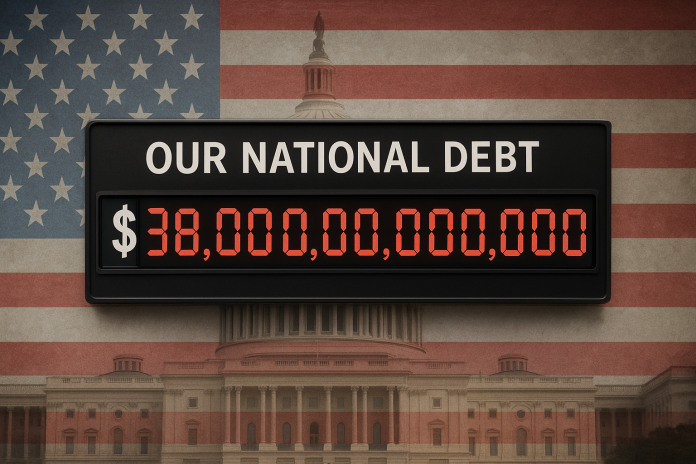The United States has reached a new record in its financial history. The country’s total national debt has now crossed $38 trillion, according to the latest data from the Treasury Department. This number represents how much money the federal government owes to creditors around the world. What makes this figure even more shocking is how fast the debt is growing — the U.S. added another trillion dollars in just two months, the quickest jump ever recorded outside the pandemic years.
America’s Fastest Trillion-Dollar Debt Increase
In August 2025, the national debt was $37 trillion. By October, it had already crossed $38 trillion. Experts say this rise happened even though there were no major emergencies or new spending programs. The government simply borrowed more to cover its regular bills, including Social Security, defense, and interest on older loans.
Economists have noted that the U.S. now adds around $70,000 in new debt every second. This rapid pace shows that the government is spending far more than it earns from taxes. The borrowing is no longer limited to times of crisis — it has become part of how the government runs every day.
The current debt level is also being reached while the government is partly shut down due to a political dispute in Congress. This makes the situation even more unusual: the government is not fully operating, yet it continues to borrow heavily.
What Rising Debt Means for Ordinary Americans
Experts warn that the growing national debt can affect daily life in several ways. Kent Smetters from the University of Pennsylvania explained that when the government owes more money, inflation can rise over time. This means the prices of food, rent, and fuel may increase faster than wages. As inflation grows, the value of each dollar falls, making it harder for people to buy homes or save for the future.
China’s Historic Dump of $53 Billion US Treasuries is Unprecedented Blow to US Economy
The Government Accountability Office also lists other effects of high national debt. These include:
- Higher borrowing costs for people taking out car loans, home loans, or credit cards.
- Lower wages, because companies have less money to invest in their workers.
- More expensive goods and services, as businesses deal with higher costs.
These financial pressures mean that as the government borrows more, the average household may have to pay more to live the same life.
Interest payments on this massive debt are also rising quickly. The U.S. has already spent about $4 trillion in the past decade just on interest — money that doesn’t reduce the actual debt. Over the next ten years, experts estimate that interest costs could rise to $14 trillion, becoming one of the largest expenses in the federal budget. This spending leaves less room for education, infrastructure, or healthcare programs.
Political Reactions and Fiscal Uncertainty
Government officials have offered mixed messages about the growing debt. The Trump administration has said that its policies are helping reduce the federal deficit — the yearly gap between spending and income. According to a statement from Treasury Secretary Scott Bessent, the deficit for April to September was $468 billion, the lowest since 2019. A White House spokesperson added that the administration has cut spending, raised revenue, and lowered borrowing costs.
Brazil Ditches the Dollar: Launches First-Ever Panda Bond in China’s Yuan
However, independent analysts say that even if the deficit temporarily shrinks, the overall debt continues to grow. This means the country is still spending more than it earns. The Joint Economic Committee reported that the total national debt has been growing at an average rate of nearly $70,000 per second over the past year.
Michael Peterson, head of the Peter G. Peterson Foundation, said that reaching $38 trillion during a shutdown shows how Congress has lost control of fiscal policy. He pointed out that interest payments are now the fastest-growing part of the budget and are beginning to take money away from essential investments in the nation’s future.
The U.S. debt figures have been climbing sharply over the past two years — from $34 trillion in January 2024, to $35 trillion in July, $36 trillion in November, and now $38 trillion in October 2025. Each increase adds more pressure on the economy, more risk to future budgets, and more uncertainty about how long the country can continue to borrow at this pace.
The debt story is not just about numbers. It is about the growing cost of maintaining America’s standard of living and the limits of political compromise.
German Bonds No Longer Sacred? Japan’s $18B Bond Sell Signals Deep Doubts in Western Economies
For now, the government continues to borrow, businesses continue to operate, and citizens continue to adapt — even as the national debt rises to levels never seen before in U.S. history.


